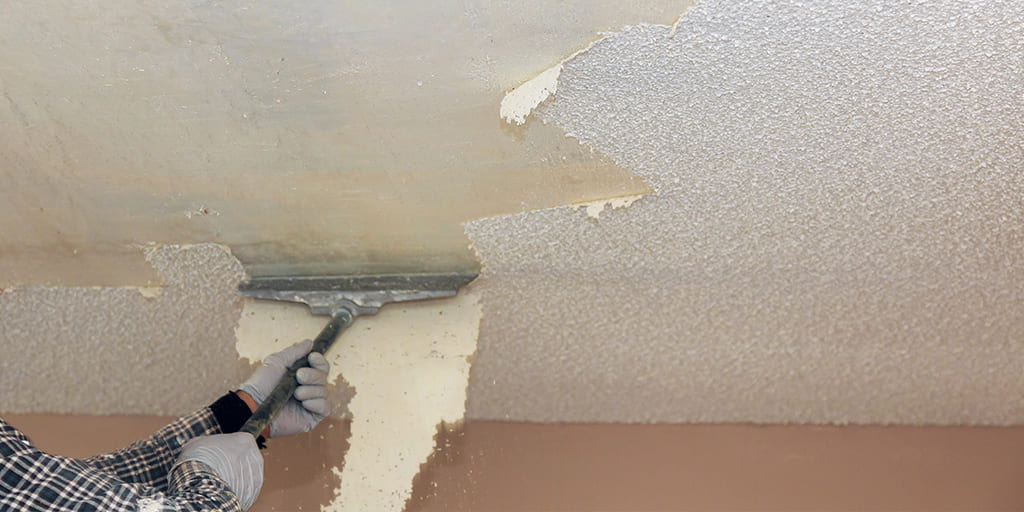What does asbestos look like in popcorn ceiling? Popcorn ceilings, also known as textured or acoustic ceilings, were popular in homes and buildings from the 1950s through the 1980s. However, one concerning aspect of many older popcorn ceilings is the potential presence of asbestos, a hazardous mineral known to cause serious health issues when disturbed. In this article, we will explore what asbestos looks like in a popcorn ceiling, its risks, and how to address this concern.

Understanding Popcorn Ceilings and Asbestos
An Aesthetic Choice with a Hidden Risk
Popcorn ceilings were initially favored for their ability to hide imperfections, dampen sound, and provide a distinctive look to a room. However, many popcorn ceilings installed before the 1980s contain asbestos, a naturally occurring mineral known for its insulating and fire-resistant properties. Asbestos was added to various construction materials, including ceiling textures, to enhance their performance.
What Does Asbestos Look Like in Popcorn Ceiling?
The Challenge of Identification
Identifying asbestos in a popcorn ceiling can be challenging because asbestos fibers are microscopic and not visible to the naked eye. Asbestos-containing materials are usually mixed with other components, making them visually indistinguishable from non-asbestos-containing materials. To determine if asbestos is present, a professional asbestos inspection is necessary.
Risks Associated with Asbestos in Popcorn Ceilings
The Health Concerns
Asbestos poses a serious health risk when its fibers become airborne and are inhaled. Prolonged exposure to asbestos can lead to health issues such as lung cancer, mesothelioma, and asbestosis. While asbestos is generally safe when undisturbed, the process of removing or renovating a popcorn ceiling can release asbestos fibers into the air, making it hazardous.
How to Identify Asbestos in Popcorn Ceilings
Professional Inspection is Key
Identifying asbestos in a popcorn ceiling requires a professional inspection. Here are the steps involved:
- Visual Inspection: A trained asbestos inspector will examine the ceiling’s texture to determine if it may contain asbestos. However, visual inspection alone is not sufficient to confirm asbestos presence.
- Sample Collection: To definitively confirm the presence of asbestos, the inspector will take a small sample of the ceiling texture. This sample is then sent to a laboratory for testing.
- Laboratory Analysis: The laboratory will analyze the sample to detect the presence of asbestos fibers. If asbestos is found, the specific type and concentration will be identified.
- Report and Recommendations: The asbestos inspection report will provide findings and, if asbestos is present, recommendations for handling or removal.
Options for Dealing with Asbestos in Popcorn Ceilings
Understanding Your Choices
Once asbestos is identified in a popcorn ceiling, you have several options for addressing the issue:
- Leave it Undisturbed: If the asbestos-containing popcorn ceiling is in good condition and not at risk of damage, one option is to leave it undisturbed. Regularly monitor the ceiling for any signs of deterioration.
- Encapsulation: Another approach is to encapsulate the asbestos-containing material by applying a sealant or covering it with a new layer of drywall or other ceiling material. This prevents the release of asbestos fibers.
- Professional Removal: The safest method to eliminate asbestos is professional removal. This should only be done by licensed and trained asbestos abatement professionals who follow strict safety procedures to prevent asbestos exposure.
Conclusion
Asbestos in popcorn ceilings poses a hidden health risk, and it cannot be visually identified. If you suspect that your popcorn ceiling may contain asbestos, it is essential to seek professional inspection and testing. Once confirmed, you can decide on addressing the issue, such as encapsulation, professional removal, or other methods. Prioritizing safety and addressing asbestos concerns in your home is crucial for the well-being of you and your family.